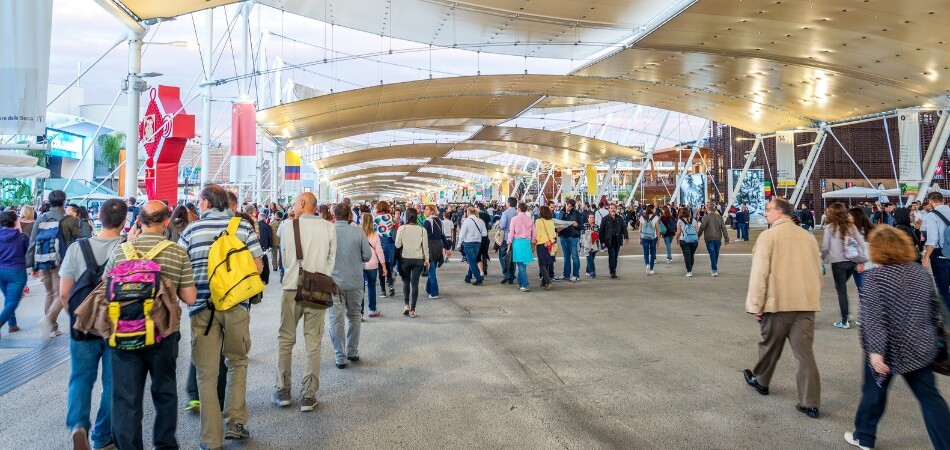The world of events is vast and varied, encompassing a range of experiences designed to engage, inform, and connect individuals. At the heart of this world, two prominent types stand out: Expos and Exhibitions. So, what is the difference between an Expo and an Exhibition?
An Expo serves as a nexus where sellers and consumers converge. Unlike exhibitions, which might have specific target audiences, Expos are designed for mass appeal. Their primary goal is to attract as much attention as possible.
Thus, they typically have the highest attendance, opening their doors to people from all sectors without barriers. While exhibitions may cater to niche audiences, Expos are all about inclusivity and widespread participation.
Definitions of Expo and Exhibition- Overviews
Events, both big and small, can captivate audiences and foster connections. Yet, within this realm, Expos and Exhibitions hold unique places. While subtle, their distinctions shape the essence of the experience they offer.

An Expo is a grand-scale event designed to draw people from diverse backgrounds. Its primary objective is to showcase innovations, products, or services, facilitating interactions between sellers and consumers. It prides itself on its inclusivity, ensuring attendees from various sectors feel welcomed and engaged.
In contrast, an Exhibition is a more targeted affair. It’s carefully curated to cater to a specific audience or sector, often focusing on a singular theme or industry. This precision allows participants to delve deep into the subject matter, ensuring a more focused and enriching experience.
While both Expos and Exhibitions aim to inform and connect, their scale and audience specificity set them apart. This very difference guides individuals and businesses in choosing which platform best serves their objectives.
Different Types of Expos
Expos are multifaceted gatherings designed to spotlight innovations, trends, and products. Though all Expos share some common traits, they diverge significantly in their purposes and themes. Let’s explore the diverse tapestry of expo types.
Trade Expos
Trade Expos are business-centric platforms dedicated to connecting industry professionals. Companies showcase their latest products or services to foster collaborations or secure potential clients. Attendees benefit from networking opportunities and gain industry insights.
Consumer Expos
Consumer Expos, unlike their trade counterparts, directly target the general public. These events display products or services that everyday consumers might purchase. It’s a chance for businesses to interact directly with their potential customers, gauging feedback and building brand awareness.
Cultural Expos
Cultural Expos celebrate the richness and diversity of human civilizations. They spotlight traditional arts, crafts, performances, and culinary delights from various regions or countries. Attendees immerse themselves in unique cultural experiences, broadening their horizons.
Each type of Expo, with its distinct focus and audience, plays a pivotal role in bridging gaps, whether they’re between businesses, consumers, or diverse cultures.
Different Types of Exhibitions
With their curated displays and thematic focuses, exhibitions offer specialized insights into myriad topics. While they all aim to inform and engage, their categorizations vary based on subject and intent. Delve into the diverse world of exhibitions below.
Art Exhibitions
Art Exhibitions illuminate the creative facets of humanity. They display paintings, sculptures, and other artistic mediums, allowing enthusiasts to appreciate or critique. These events often become cultural milestones or discussion points.
Museum Exhibitions
Museum Exhibitions, often permanent or temporary, provide historical or scientific insights. They feature artifacts, dioramas, and interactive elements, ensuring education intertwines with entertainment. Visitors leave with expanded knowledge and newfound curiosity.
Commercial Exhibitions
Commercial Exhibitions serve business aims, presenting products or services to potential clients or partners. They’re pivotal for sectors like technology, automobiles, and fashion. Businesses gain exposure, and attendees explore industry advancements.
Through these diverse exhibitions, society gains access to art, history, science, and commerce, reflecting the multifaceted nature of human endeavors and curiosities.
What is the Difference Between an Expo and an Exhibition?
Expos and exhibitions, though often used interchangeably, embody distinct purposes and formats. Each has its unique charm, resonating with diverse audiences for varied reasons. Here, we’ll navigate the nuanced differences between the two.

Primary Objectives and Aims
Expos predominantly serve as vast convergence points, amalgamating various industries and ideas in a singular space. They aspire to foster global connections, stimulate economic growth, and spotlight innovations. Exhibitions, on the other hand, are concentrated events, typically emphasizing a solitary theme, product, or industry to engage a more targeted audience.
Magnitude and Outreach
Expos, especially those of international acclaim, are mammoth events, orchestrating a wide spectrum of sectors and often drawing participants from across the globe. Their expansive footprint facilitates diverse interactions. In contrast, exhibitions maintain a narrower scope, catering to enthusiasts, professionals, or consumers keen on the event’s particular subject.
Event Duration and Regularity
Major Expos, such as the World Expos, are monumental affairs that occur once every five or ten years and span several months. Their planning can be years in the making. Exhibitions are relatively frequent, often annually or biannually, with durations ranging from a day to several weeks.
Targeted Demographics
Expos cast a wide net, appealing to an assorted audience: industry experts, entrepreneurs, consumers, and even policy-makers. Their allure lies in their inclusivity. Exhibitions, however, are curated for a specified demographic, aligning closely with the event’s focal point.
Participation of Exhibitors
In an Expo, one might find a diverse array of participants – from tech startups to established multinational corporations, each aiming to captivate the vast influx of visitors. Exhibitions, due to their thematic nature, usually house exhibitors belonging exclusively to the event’s central theme or industry.
Depth of Interaction and Engagement
Expos provide a broad platform for myriad interactions, from business deals to cultural exchanges. Attendees often graze multiple sectors. Exhibitions present an opportunity for an in-depth exploration of a particular topic, fostering profound discussions and a higher degree of specialization.
The blend of Cultural and Commercial Endeavors
While some Expos, especially global ones, prioritize cultural representation, allowing nations to display their cultural and technological prowess, others can be heavily commercial. Exhibitions oscillate between purely commercial ventures, artistic displays, or educational endeavors.
In essence, while both Expos and exhibitions serve as platforms for display and interaction, their scale, audience, and focus differentiate them. These distinctions help businesses and attendees choose the right event for their objectives.
Pros and Cons of Expo Events
With their large-scale gatherings and diverse offerings, expo events bring about many benefits and challenges. Like any significant endeavor, they carry both advantages and potential pitfalls. Here’s a snapshot of the pros and cons of Expo events:
Pros:
- Diverse Audience Engagement: Attract a wide array of attendees from different sectors and backgrounds.
- Business Networking: Facilitate connections, collaborations, and partnerships between industries.
- Showcase Innovations: Platform to introduce and demo groundbreaking products or services.
- Cultural Exchange: Opportunities for nations or regions to display their cultural richness.
- Boost Local Economy: Increased tourism and business engagements benefit the host city or country.
- Educational Experiences: Visitors gain knowledge about various industries, cultures, and technological advancements.
- Brand Visibility: Businesses can amplify their brand presence on a large scale.
Cons:
- High Costs: Organizing or participating can entail substantial financial investments.
- Overwhelming Size: This can be challenging to navigate and cover comprehensively for attendees.
- Competition Intensity: Many participants vie for visitor attention, making standout displays essential.
- Logistical Challenges: Managing large crowds, security, and amenities requires meticulous planning.
- Environmental Concerns: Large events might lead to increased waste and carbon footprints.
Balancing the immense potential and challenges, Expo events are nevertheless a significant avenue for networking, learning, and cultural immersion.
Pros and Cons of Exhibition Events
Exhibition events, tailored to provide specialized insights on focused topics, come with their own set of advantages and limitations. Their targeted nature defines both their strengths and challenges. Let’s delineate the pros and cons of these events:
Pros:
- Thematic Depth: Dive deep into specific subjects, facilitating profound understanding and exploration.
- Targeted Audience Engagement: Reach an audience specifically interested in the showcased theme or industry.
- Business Opportunities: Connect with potential clients or partners in a focused environment.
- Curated Content: Carefully selected displays ensure relevance and high-quality offerings.
- Flexible Formats: Exhibitions can adapt to various sizes, from local to international scales.
- Immediate Feedback: Direct interactions with attendees allow instant feedback and insights.
- Enhanced Brand Loyalty: Engaging deeply with a niche audience fosters strong brand connections.
Cons:
- Limited Outreach: This may not attract a diverse crowd outside the theme or industry.
- High Participation Costs: Stalls or displays can be expensive, especially at premier events.
- Potential Oversaturation: Similar events might compete for the same target audience.
- Rapid Evolution: Frequent changes in industry trends may render some exhibitions outdated quickly.
- Logistic Demands: Organizing, especially large-scale exhibitions, demands meticulous coordination and planning.
Despite the potential challenges, exhibition events remain a cornerstone for businesses and industries to present their offerings, gain feedback, and connect intimately with their target audience.
End Notes
The realm of events offers a vast spectrum of experiences, with Expos and Exhibitions standing out due to their distinctive natures and objectives.
Delving into their nuances, one discerns that while Expos seek to cast a wide net, attracting diverse audiences and facilitating broad interactions, Exhibitions offer a more concentrated experience, targeting specific themes or industries. It brings us back to the question, “what is the difference between an Expo and Exhibition?”
Essentially, it boils down to their scale, audience, and depth of engagement. Both play pivotal roles in fostering connections, promoting innovations, and enriching our knowledge. Choosing between them depends largely on one’s objectives, whether broad outreach or focused engagement is the goal.


